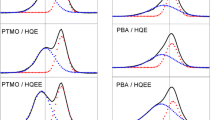Abstract
Two series of biomedical segmented polyurethanes (SPU) based on poly(ε-caprolactone) diol (PCL diol), 1,6-hexamethylene diisocyanate (HDI) or l-lysine methyl ester diisocyanate (LDI) and three novel chain extenders, were synthesized and characterized. Chain extenders containing urea groups or an aromatic amino-acid derivative were incorporated in the SPU formulation to strengthen the hard segment interactions through either bidentate hydrogen bonding or π-stacking interactions, respectively. By varying the composition of the hard segment (diisocyanate and chain extender), its structure was varied to investigate the structure-property relationships. The different chemical composition and symmetry of hard segment modulated the phase separation of soft and hard domains, as demonstrated by the thermal behavior. Hard segment association was more enhanced by using a combination of symmetric diisocyanate and urea-diol chain extenders. The hard segment cohesion had an important effect on the observed mechanical behavior. Polyurethanes synthesized using HDI (Series H) were stronger than those obtained using LDI (Series L). The latter SPU exhibited no tendency to undergo cold-drawing and the lowest ultimate properties. Incorporation of the aromatic chain extender produced opposite effects, resulting in polyurethanes with the highest elongation and tearing energy (Series H) and the lowest strain at break (Series L). Since the synthesized biodegradable SPU possess a range of thermal and mechanical properties, these materials may hold potential for use in soft tissue engineering scaffold applications.











Similar content being viewed by others
References
G. Oertel, Polyurethane Handbook (Hanser Gardner Publications, Berlin, 1994)
P.A. Gunatillake, R. Adhikari, Eur. Cell. Mater. 5, 1 (2003)
Gorna K, Gogolewski S in Synthetic Bioabsorbable Polymers for Implants. ASTM STP 1396, ed. by C.M. Agrawal, J.E. Parr, S.T. Lin (American Society for Testing and Materials, West Conshohocken, PA, 2000), p. 39
S.A. Guelcher, Tissue Eng. Part B 14, 3 (2008)
A. Marcos-Fernández, G.A. Abraham, J.L. Valentín, J. San Román, Polymer (Guildf) 47, 785 (2006). doi:10.1016/j.polymer.2005.12.007
C. Alperin, P.W. Zandstra, K.A. Woodhouse, Biomaterials 26, 7377 (2005)
K.L. Fujimoto, J. Guan, H. Oshima, T. Sakai, W.R. Wagner, Thorac. Surg. 83, 648 (2007). doi:10.1016/j.athoracsur.2006.06.085
J. Guan, K.L. Fujimoto, M.S. Sacks, W.R. Wagner, Biomaterials 26, 3961 (2005). doi:10.1016/j.biomaterials.2004.10.018
K. Gisselfält, B. Edberg, P. Flodin, Biomacromolecules 3, 951 (2002). doi:10.1021/bm025535u
R.G.J.C. Heijkants, R.V. van Calck, T.G. van Tienen, J.H. de Groot, P. Buma, A.J. Pennings, A.J. Pennings et al., Biomaterials 26, 4219 (2005). doi:10.1016/j.biomaterials.2004.11.005
C.J. Spaans, J.H. de Groot, F.G. Dekens, A.J. Pennings, Polym. Bull. 41, 131 (1998). doi:10.1007/s002890050343
S.A. Guelcher, K.M. Gallagher, J.E. Didier, D.B. Klinedinst, J.S. Doctor, A.S. Goldstein et al., Acta Biomater. 1, 471 (2005). doi:10.1016/j.actbio.2005.02.007
K.D. Kavlock, T.W. Pechar, J.O. Hollinger, S.A. Guelcher, A.S. Goldstein, Acta Biomater. 3, 475 (2007). doi:10.1016/j.actbio.2007.02.001
S.A. Riboldi, N. Sadr, L. Pigini, P. Neuenschwander, M. Simonet, P. Mognol et al., J. Biomed. Mater. Res. 84A, 1094 (2008). doi:10.1002/jbm.a.31534
J.J. Stankus, J. Guan, K. Fujimoto, W.R. Wagner, Biomaterials 27, 735 (2006). doi:10.1016/j.biomaterials.2005.06.020
M. Borkenhagen, R.C. Stoll, P. Neuenschwander, U.W. Suter, P. Aebischer, Biomaterials 19, 2155 (1998). doi:10.1016/S0142-9612(98)00122-7
M.D. Lelah, S.L. Cooper, Polyurethanes in Medicine (CRC Press Inc, Boca Raton, Florida, 1986)
G.A. Skarja, K.A. Woodhouse, J. Biomater. Sci. Polym. Ed. 9, 271 (1998). doi:10.1163/156856298X00659
Moore T, Ph.D. Thesis (Swinburne University of Technology, Australia, 2005)
J. Guan, M.S. Sacks, E.J. Beckman, W.R. Wagner, J. Biomed. Mater. Res. 61, 493 (2002). doi:10.1002/jbm.10204
J.H. de Groot, R. de Vrijer, B.S. Wildeboer, C.J. Spaans, A.J. Pennings, Polym. Bull. 38, 211 (1997). doi:10.1007/s002890050040
G.A. Abraham, A. Marcos-Fernández, J. San Román, J. Biomed. Mater. Res. 76A, 729 (2006). doi:10.1002/jbm.a.30540
K. Gorna, S. Gogolewski, Polym. Deg. Stab. 75, 113 (2002). doi:10.1016/S0141-3910(01)00210-5
P.C. Caracciolo, A.A.A. de Queiroz, O.Z. Higa, F. Buffa, G.A. Abraham, Acta Biomater. 4, 976 (2008). doi:10.1016/j.actbio.2008.02.016
D.W. Van Krevelen, Properties of Polymers (Elsevier, Amsterdam, 1990), p. 121
C.J. Spaans, J.H. de Groot, V.W. Belgraver, A.J. Pennings, J. Mater. Sci. Mater. Med. 9, 675 (1998). doi:10.1023/A:1008922128455
G.A. Skarja, K.A. Woodhouse, J. Appl. Polym. Sci. 75, 1522 (2000)
G.M. Estes, S.L. Cooper, A.V. Tobolski, J. Macromol. Sci. Revs. Macromol. Chem. C4(2), 313 (1970)
J.A. Miller, S.B. Lin, K.K.S. Hwang, K.S. Wu, S.L. Cooper, Macromolecules 18, 32 (1985). doi:10.1021/ma00143a005
T.D. Wang, D.J. Lyman, J. Polym. Sci. Polym. Chem. 31, 1983 (1993). doi:10.1002/pola.1993.080310806
J.H. de Groot, R. de Vrijer, A.J. Pennings, J. Klompmaker, R.P.H. Veth, H.W.B. Jansen, Biomaterials 17, 163 (1996). doi:10.1016/0142-9612(96)85761-9
Acknowledgements
P.C. Caracciolo thanks to National Research Council (CONICET, Argentina) for the fellowship awarded. The authors would like to acknowledge the financial support of National Agency for the Promotion of Science and Technology (ANPCyT, Argentina), CONICET, and National University of Mar del Plata (Argentina).
Author information
Authors and Affiliations
Corresponding author
Rights and permissions
About this article
Cite this article
Caracciolo, P.C., Buffa, F. & Abraham, G.A. Effect of the hard segment chemistry and structure on the thermal and mechanical properties of novel biomedical segmented poly(esterurethanes). J Mater Sci: Mater Med 20, 145–155 (2009). https://doi.org/10.1007/s10856-008-3561-8
Received:
Accepted:
Published:
Issue Date:
DOI: https://doi.org/10.1007/s10856-008-3561-8




